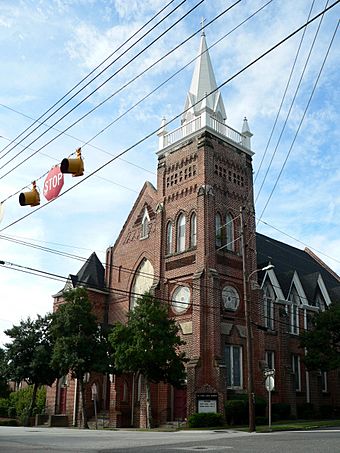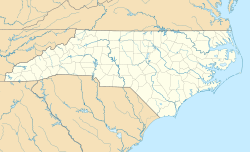St. Paul A.M.E. Church (Raleigh, North Carolina) facts for kids
Quick facts for kids |
|
|
St. Paul A.M.E. Church
|
|
 |
|
| Location | 402 West Edenton St., Raleigh, North Carolina |
|---|---|
| Built | 1884 |
| Architectural style | Late Gothic Revival |
| NRHP reference No. | 80004607 |
| Added to NRHP | November 5, 1987 |
The St. Paul A.M.E. Church is a very old and important church in Raleigh, North Carolina. It was built in 1884 and has a beautiful Gothic Revival style. This church was built by African American masons. It was the first independent church for African Americans in Raleigh. It is also the oldest African American church in Wake County, North Carolina.
Before the American Civil War, the people who later started St. Paul's were members of another church. They were part of the Edenton Street Methodist Episcopal Church. These members started calling their group "St. Paul's" in 1848. The church is now a special historic place. It was added to the National Register of Historic Places in November 1987. It is also known as a Raleigh Historic Landmark.
Contents
History of St. Paul A.M.E. Church
The St. Paul A.M.E. Church has a long and interesting history. It played a big role in the lives of African Americans in Raleigh.
Early Beginnings
From 1846 to 1853, the African American members of the Edenton Street Church met at Old Christ Church. In 1853, white Methodists bought that building. So, the members moved to a different building. It was located where Edenton and Harrington streets meet.
After slavery ended in 1865, the African American group left the Edenton Street Church. They joined the African Methodist Episcopal Church. This church group was started in 1816 by Reverend Richard Allen. He was a free African American man from Philadelphia, Pennsylvania. St. Paul's became the first African Methodist church in Raleigh and Wake County.
A Place for Leaders
St. Paul's Church was a place where important leaders gathered. It also helped new leaders grow. After slavery was abolished, the ministers of St. Paul's became leaders. They were active in politics during the Reconstruction period. Raleigh, as the state capital, became a center for African American political action.
Many important African American spokesmen were members of St. Paul's. These included State Senator Henry Eppes and Legislator Stewart Ellison. R. W. H. Leak, a leader in the Republican-Populist movement, was also a member.
Women in the church were also very active. They formed groups to help women and children. They worked on issues like welfare, health, and education. The African American community strongly believed in educating their children. The church connected education to the well-being and future of the community.
Building the New Church
In 1884, the first stone for the new church was laid. Building the new St. Paul's Church took 25 years to finish. This was because the members faced financial difficulties. Many people in the Southern United States struggled after the Civil War.
Members of the church earned lower wages because of segregation. They chose to live very simply, sometimes eating only bread and molasses. They did this to save enough money to complete the church.
In May 1901, the main building was finally finished. The church celebrated with a joyful two-week revival meeting. Governor Charles B. Aycock gave a speech when the church opened. The News & Observer newspaper called St. Paul's new building "one of the handsomest colored churches in the South."
The tall spire on top of the church was not built until eight years later. In 1909, an accidental fire destroyed most of the building. Only the brick walls were left. People from both the white and African American communities donated money. This helped rebuild the church and add the planned spire. In 1909, the building was also updated by African American architect Gaston Alonzo Edwards.
Continuing Its Important Role
During the Civil Rights Movement, St. Paul's continued to be a center for community organizing. Many meetings and rallies were held there. Church members had always worked to help people register to vote. Raleigh had many educated African American residents. This meant more people were registered to vote there than in other areas.
In the 1960s, after the Voting Rights Act was passed, the community worked even harder. They encouraged more people to register and vote in elections.
Many national speakers visited the church. For example, in 1988, Jesse Jackson gave a "Rainbow Coalition" speech there.
Today, Rev. Dr. Larry McDonald is the pastor of St. Paul A.M.E. Church. The church has about 900 members. St. Paul A.M.E. Church remains a very important historic place in downtown Raleigh, North Carolina.
See also



